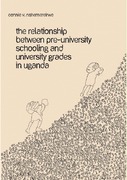| dc.description.abstract | Universities are concerned with selecting students with the highest potential for successfully pursuing university education. For universities in Uganda, this potential is, apparently, sufficiently indicated by student performance in the national examinations at the end of the advanced level (A’Level) of secondary school. However, performance trends at A’Level indicate that there is a wide variation in performance between the different subjects offered at A’Level, as well as between different schools. Further, since the national examinations represent such high stakes, there are reports of a heavy emphasis on teaching and learning strategies aimed at maximising pass rates, which is further accompanied by a tendency to choose the A’Level subjects that consistently exhibit high pass rates. Since university selection depends almost solely on scores in the A’Level national examinations, it was of interest to investigate the extent to which these
university entry scores predicted university grades after taking account of the various school and student level factors present in the pre-university schooling system. The main student level variables included in the study were student age and socioeconomic status (SES), while school level variables concerned ownership (public vs. private), gender balance (single-sex vs. coeducational), whether or not schools provided boarding facilities, and finally whether or not they run the Universal Secondary Education programme (USE). The USE is a government funded programme that provides tuition free
education to students, and can be accessed at selected public and private secondary schools.
The majority of university students in Uganda is enrolled at the country’s 5 public universities, with the largest public university accounting for about 30% of university enrolments nationwide. In the last 20 years, more than 30 private universities have also been established but these boast much lower enrolments, only accounting for 15% of total university enrolment (National Council for Higher Education, NCHE, 2013). Selection requirements at public and private universities are similar, but while selection into private universities is carried out at university level, selection into public universities is carried out jointly by a central body at the ministry of education. This is partly to facilitate the award of about 3,000 merit-based state sponsored scholarships which are only available to students enrolled at public universities. The availability of state scholarships at public universities has made entry highly competitive. Further, since the majority of prospective university students would like to be considered for these scholarships, the entry requirements for the academic programmes at public universities heavily influence subject choice at A’Level.
The subject requirements and associated weighting for admission into the various academic programmes offered at public universities are published every year before students sit their A’Level examinations. Table 1 shows the entry requirements for some of the more selective and some of the less selective academic programmes offered at
public universities. As can be seen, the more selective programmes like Telecom Engineering and Human Medicine have specific subject requirements, while programmes like Development Studies and Law have none at all. | en_US |


